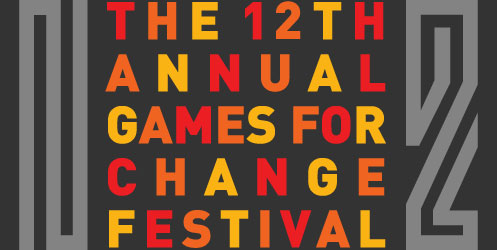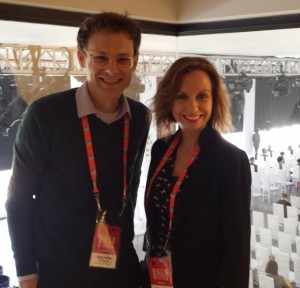
When it comes to games, what exactly do we mean by impact? How do our different interpretations hold us back, and how can we bridge them to move forward?
These questions have spurred a new Games for Change research project (seehttp://GameImpact.net), which seeks to create shared language around impact games and improve collaboration between designers and researchers. The first report of the series, titled “Impact with Games: A Fragmented Field,” lays out the challenges the series will address. An open draft of the report will be released for public comment by the project’s Advisory Group Chair, Co-Founder of Games for Change and incoming American University Assistant Professor Benjamin Stokes, at the Games for Change Festivalon April 22.
The release will come the day after the Festival’s “Optimizing for Impact and Creativity” panel, which features Stokes along with the Center for Media & Social Impact’s incoming Co-DirectorCaty Borum Chattoo. Other speakers will include Colleen Macklin of PETLab and Parsons The New School for Design, and Katherine Isbister of New York University’s Game Innovation Lab.
Games for Change intends the “Fragmented Field” report to serve as the project’s baseline, establishing the problems and the need for deeper understanding of the “big picture.” Future reports will begin to delve into solutions. In a conversation with CMSI, Stokes discussed the project’s overarching goals, its importance for both researchers and designers, and its relevance to other impact media.
Inspiration
“One of the things I love about games is that they’re team projects,” said Stokes. However, members of those teams often have very different views on the nature of impact. “I was seeing a real fragmentation, people talking past each other in different areas,” Stokes said. For example, a scholar trained in education might define impact as individual learning, while a political scientist might look for impact in how a group mobilizes to shift the public will.
These disconnects create what Stokes calls multidisciplinary “fault lines,” places where impact “falls into the cracks and disappears.” Types of impact that don’t fit convenient definitions get lost, which Stokes said is particularly damaging for games that are “on the edge,” like experimental games. “I think we’re overlooking some of what games can do,” said Stokes. “We could actually have deeper impact if we had better language to talk across stakeholders and disciplines.”
Primary Goals
“This report is about bringing together different stakeholders,” Stokes said. “One of our greatest opportunities is to narrow the gap between the kinds of formative assessment that creative types are already doing and the kind of summative assessment that researchers are doing.”
It’s also about rethinking the way we classify impact games. Stokes explained two approaches to classification; the dominant one right now classifies by sector or discipline. For example, we talk about “education” games and “health” games — even though there is substantial overlap. An alternative approach, which future reports will explore, classifies according to the underlying category of impact. “The main solution that we are starting to build toward is to organize more of our conversations around impact, and less around technology or game genre,” said Stokes. “Sometimes the greatest impact is unintended, and for a new field we have to be open-minded to that.”
Finally, the project is also about power and empowerment. “when people feel like others are defining their impact, that can be really scary,” said Stokes. “If you lack the language and tools to describe your own impact, then whatever you care most about might not even be counted. So to me, assessment is very much about power.” Quite often, the person in power gets to define impact. To address this imbalance, Stokes said, we need to have conversations about power and create ways for “ordinary designers to think of themselves partly as ‘impact designers’, not just game designers.”
Games for Change chose to release the first report as an “open draft” in order to help start that conversation. “This open draft period is a way of modeling some of what we think should be in the actual assessment process, which is a more iterative approach that emphasizes good listening across stakeholders,” said Stokes. “Openness for us is an important part of our process.”
Broader Impact & Ties to Film
“Games and film have a lot to learn from each other in terms of understanding impact,” said Stokes. “If you’re a filmmaker doing a little interactivity, look at a game that’s doing a little bit of film and the contrasts are often very insightful”
For example, said Stokes, good games require giving players meaningful choices. “In games, choice is often the best way to understand the meaning of the game.” The key is that the choices have to be real – not hitting the player over the head with just one “right answer.” “Meaningful choice requires that more than one pathway is taken seriously,” said Stokes. In film on the other hand, choices tend to be much more limited, presented in terms of watching or not watching, with the real action after the media experience is over. “I think there are a number of deep concepts that come out of games, like meaningful choice, which could be highly useful for filmmakers who are branching into interactive media,” said Stokes.
The overlap of games and film is particularly relevant in the age of media convergence, as the lines between forms are increasingly blurred. Games include film clips, online films often include game elements, and both are often embedded in larger contexts. “I’m very interested in what I call real-world games or real-world films, that are not just about something but are actually part of something,” said Stokes. “In this case, making progress in the game means affecting the real world too — raising funds, or just connecting people together.” Real-world design requires and should begin with this multiform “embeddedness.” As games increasingly blur with the real-world, , Stokes said, “it’s important not only to understand “pure games” and “pure film,” but also to look at “the gray space in between.”
Future Projects at AU & CMSI
“As a new faculty member coming to American University, it’s exciting to tap the conversation I’ve been having with Games for Change for more than a decade,” said Stokes. This first report is also one of the first connective projects between CMSI and the American University Game Lab, which focuses on persuasive play. “Those connections, those synergies are just starting to emerge,” said Stokes. “This report points to how games can fit into the longstanding CMSI investigation of impact with media.”
This project is ultimately aiming to reframe the conversation on impact design. “Success would be if — five years from now — we can look back and admit that we used to have a hard time collaborating across sectors, but that now we have a language (and evaluative tools) across forms of media and across stakeholders.” Said Stokes, “we must help designers achieve deeper ownership over the terms for assessment, and researchers may need to better integrate with the creative process as well.”

